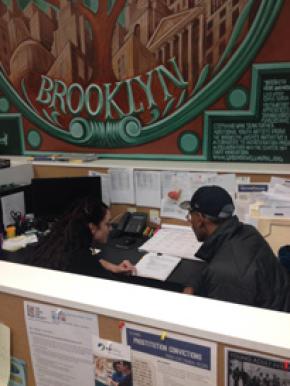Meaningful Alternatives to Incarceration
Each year, the Center for Court Innovation helps to reduce the use of jail in New York by providing meaningful alternatives to incarceration to tens of thousands of defendants.

Brooklyn Justice Initiatives operates out of Brooklyn's centralized criminal court
This is not a typo: we link tens of thousands of New Yorkers to community-based services each and every year. As 2014 draws to a close, I hope you will consider making a contribution to support these efforts.
One of the hidden truths about the criminal justice system is that the vast majority of cases involve low-level offenses; in New York City, for example, three out of four criminal cases are misdemeanors. The charges may be minor, but these defendants still face serious consequences, including the possibility of time on Rikers Island. In places like Brownsville, Midtown, and the Bronx, we are providing judges with meaningful options beyond jail, including community restitution projects, job training classes, and counseling sessions. This includes the award-winning Red Hook Community Justice Center, which was documented by independent evaluators to reduce both crime and incarceration in southwest Brooklyn.
We are also working to reduce pre-trial detention. All too many people are incarcerated while their cases are pending – many because they lack the money to post even minimal bail amounts. With the support of New York State Chief Judge Jonathan Lippman, we have launched a supervised release program in Brooklyn. By providing rigorous monitoring (and regular reminders of court dates), Brooklyn Justice Initiatives allows participants to remain in the community until the conclusion of their criminal case.
A typical participant is Rick, 21, who was facing a year in jail for allegedly damaging a neighbor’s property. Although Rick had no criminal record, the prosecutor requested $2,500 bail because he had two other pending cases. Rather than setting bail, the judge released Rick at arraignment to Brooklyn Justice Initiatives. With the help of our case managers, Rick was linked to voluntary educational services; he was able to earn a high school equivalency diploma and enroll in a college preparatory course. Rick never missed a required appointment or court appearance and, after two months, his criminal case was dismissed and sealed.
These are the kinds of outcomes that the Center for Court Innovation is achieving every day. I hope you will consider supporting our work with a year-end contribution. To donate, please click here.

